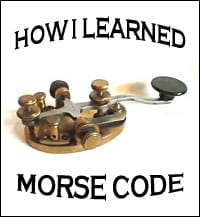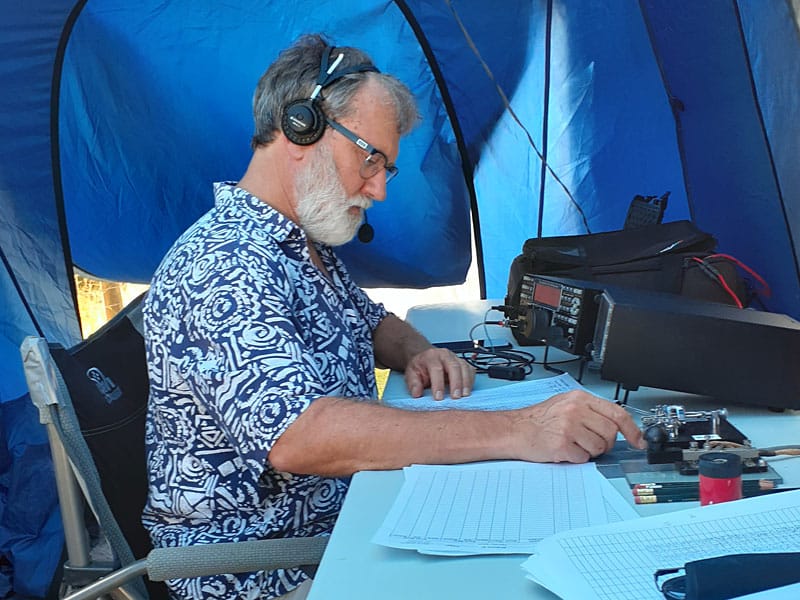This is a fortnightly newsletter about the New Zealand Net. If you would like to be notified by email when a new edition is published, please contact ZL1NZ.
Browse our newsletter Archive and List of Net Tips.
Featured key

Photo: Jan van Ooijen PA3EGH
This simple and elegant key is the famous Bunnell Double-Speed Key, made in the USA. It’s a sideswiper, sometimes called a “cootie” key, in which character elements are sent alternately on the left and right contacts. If you look closely, you can see the clever spring tension adjustment, a sliding block that varies the insertion of the spring into the anchor block at the right of the photo.
PA3EGH has lovely photos of his Double-Speed key on his website.
Although many people believe that this key was introduced in the 1880s, John Casale W2NI disagrees. On his website he writes:
The very first ad that I could find for the Double Speed Key was in the Journal of the Telegraph, dated November 20, 1904. If you think about what was going on in the telegraph industry in 1904, the Double Speed Key’s arrival at this point in time makes a lot of sense. The wave of horizontally operated semi automatic keys and the interest in them was rapidly growing. Horace Martin’s patent for his Autoplex was granted in June of 1903 and during 1904 he was actively selling them. In January of 1904, William Coffe filed for his patent for an all mechanical vertical key and beginning in January of 1905, the Mecograph Company, operating initially off of Coffe’s patent, were advertising a semi automatic key. All this followed by Martin’s spring 1905 introduction of the Vibroplex.
I strongly recommend a visit to both the websites mentioned above.
* If you have an interesting key for this feature, please send me a nice clear photo and a few words describing it.
Quick notes
 WELCOME to the 50th edition of NZ Net News. Thanks very much for reading, and please feel free to share the newsletter with friends in New Zealand and overseas.
WELCOME to the 50th edition of NZ Net News. Thanks very much for reading, and please feel free to share the newsletter with friends in New Zealand and overseas.
So, we awoke today to tsunami warnings for much of the country. What next, huh? As far as I know, none of our Net members had to evacuate their homes. So now we can get back to worrying about Covid, although the news there is good too, with alert levels going down on Sunday morning.
Dave ZL4LDY is off the air indefinitely due to technology problems which, we hope, he is able to resolve soon.
Steve ZL2KE has upgraded to an IC-7300 and is really enjoying the new rig. He is also setting up a new shack and a tower/beam.
List of Net Tips. I get notes from NZ Net members asking about particular aspects of net operations. Sometimes these are subjects I have already talked about in the Net Tips section of NZ Net News – so I decided to make a list of Net Tips. You can find it on the main newsletter archive page. I’m sure there must be things we haven’t covered yet, so if you’d like me to write about something, let me know – or (subtle hint) maybe you’d like to write it yourself for NZ Net News.
Express message service takes Blenheim by storm

‘Pedals’ van Antwerpen with his latest load of radiograms
What’s the fastest thing on two wheels in Blenheim? That’s easy – it’s the NZ Net message delivery boy!
Check this amazing performance:
- 9pm, 3 March on NZ Net: Gerard ZL2GVA copies 3 messages for addresses in Blenheim
- The next day he hops on his delivery bicycle and pops them in letterboxes across the city
- 9pm, 4 March on NZ Net: He sends a SVC message to the originating station, reporting all delivered.
- As if that wasn’t enough, he sends replies to two of the messages the following night!
Consistent with the high efficiency of NZ Net, the original three messages (congratulatory radiograms to newly licensed radio amateurs) were sent to ZL2GVA as Booked Messages. You can learn more about that in this edition’s Net Tips.
Net numbers

Following a dip in January, net check-ins increased to 139 in February. The number of stations checking in also increased, to 16. There were 29 pieces of formal traffic passed during the Net. It is very encouraging to compare the numbers to a year earlier (see graph above).
NR21 R ZL1NZ 41/38 AUCKLAND 0800Z 1MAR21 = NZ NET = FEB QNI ZL1AJY 8 ZL1ANY 17 ZL1BWG 17 ZL1NZ 20 ZL1PC 1 ZL2GD 12 ZL2GVA 19 ZL2KE 14 ZL2LN 3 ZL2WT 2 ZL3RX 1 ZL4CU 4 ZL4KX 8 ZL4LDY 3 VK3DRQ 2 VK4PN 8 TOTAL 139 QTC 29 = ZL1NZ
Photo flashback

Graham Alderson ZL3AAD, Break-In magazine, May 1980
Morse musing: learning the code
Our series continues, this time with Gavin ZL1BBW recalling how he learned the Code. If you haven’t sent me your story yet, please do!

I learned Morse at Brighton Technical College as part of the Radio Amateurs Exam course in about 1967. Two very interesting people taught the Morse part, Tom Henly G2CMH and Cyril Fairley G3YY. My dad was also an amateur.
It was the traditional method of learning so many letters a week, then more and more – none of this Farnsworth business. I think it was about 8 or so wpm at first – just too fast to count the dits – then a bit faster, eventually within a year reaching about 15wpm, to give a bit of headroom for the test.
Absolute accuracy was always the key to the whole effort.
This stood me in good stead for when I went to Radio College (Norwood Technical College in South London) in about 1969. The Morse tutor there was a very stiff, no-messing-about chap.

Gavin, working at Portishead Radio GKA
“I understand one of you can do some Morse?”
“Yes, me.”
“Well copy this.”
So he sent a bit a about 10wpm. I handed it to him. All good.
“Try this.”
Up to about 15, again good.
“Well try this,” as he rattled off at 20ish.
I handed him the sheet and promptly got told to “go away” or words to that effect and come back at the end of the year.
We used to have to check our sending on a printed paper-tape machine with a ruler. 3:1 and that was it.
The other thing we had to be able to precisely was send the AutoAlarm signal by hand: a 4-second dash, then a 1-second space, and send 12 of them with nil room for error.
I was taught to type at the same time, that was another life-forming experience. With a cover on the keyboard, typing asdf;lkj asdf;lkj to the timing of a beaten ruler by the leading lady of the secretarial department, and woe if all your letters were not of the same darkness of ink, that was another round of it.
For a good laugh, check out these stories from Portishead Radio.
How did you learn CW? Drop me a line and I’ll post the replies in future newsletters.
Field Day
I was pleasantly surprised by the large number of CW stations taking part in the Jock White Field Day last weekend, as well as the high standard of operating. A few other CW ops have made the same comment to me. Naturally, NZ Net members were well represented.

North Canterbury ARC (Branch 68) believes in total luxury for its operators. Look at that amazing chair! No wonder they do so well. Pictured: Grant ZL2GD who kept 40 metres humming for ZL3RR. Photo: ZL3DMC

Lurking in the shadows: Paul ZL1AJY on 40m at ZL1XH, assisted by Olivier ZL1XS. Photo: ZL1KNI

Known mostly for his pencil collection, Neil ZL1NZ on 80m at ZL1XH. Photo: ZL1KNI
- Gerard ZL2GVA operated at ZL2KS (Branch 22) and reports a very good turnout of 6-7 CW ops for the Marlborough club effort.
- Gavin ZL1BBW operated 80m at ZL1AM (Branch 28)
- Richard ZL4FZ and Rob ZL3RX operated 80m at ZL3AC (Branch 05)
- Bruce ZL1BWG, Les ZL2JU and David ZL2WT participated from their home stations.
- Apologies if I’ve missed anyone.

Sign of the times. Photo: ZL1NZ
Video: Canadian landline telegraphist Lavina Shaw
Net tip: Booked messages
 Booked messages are used when we want to send several messages with identical parts – without having to repeat ourselves needlessly.
Booked messages are used when we want to send several messages with identical parts – without having to repeat ourselves needlessly.
There was an example on the Net this week, when I sent a Book to ZL2GVA (audio link below).
My messages were going to three people at three different Addresses, but the Text and Signature were the same in all three messages, so those parts were sent only once. Most of the Preamble was also sent only once, but I had to send separate Message Numbers (this is true for all booked messages). I also had to send separate Check Numbers, because the Addresses had varying numbers of words.
Here are the main things to remember when sending booked messages:
- Tell the receiving station you will be sending a book of x messages, by sending “Book of X”. Traditionally we spell out the number.
- Send the common parts of the messages first. In this case, I sent most of the Preamble, all of the Body Text and all of the Signature.
- Then send the variable parts of each message. In this case, this was the Message Number, the Check Numbers, and the Address. For extra clarity, I sent “CK” before the Check Numbers.
- Then announce “End of Book”.
I separated the sections of the Book (common elements, first variable elements, second variable elements, third variable elements) with TWO double dashes, while using one double dash to separate the parts of the message, as usual. ARRL style is to use only one double dash, but I think using two makes it clearer.
Here’s what it sounded like.
You might wonder: “How does the receiving operator know which parts of the book are common and which are variable?” That’s a good question, because there is nothing explicit about that in the way a book is sent. In the audio above, you’ll hear me go straight from the common elements of the Preamble to a double dash and then to the Body Text, whereas the Preamble would normally be followed by the Address. Indeed, sometimes the Address is a common element (if we are sending multiple messages to the same person). So, the receiving operator has no way of knowing if they are hearing the start of the Address or something else, and they simply have to “figure it out”. Not ideal, perhaps, but it seems to work.
Because we don’t do many of them, booked messages can seem confusing, but they do save lots of time. I recommend giving it a try, but you might want to type out the entire transmission first for ease of sending, which is what I did before sending this one.
The operator who delivers the messages writes or types each one on a separate message form, just as if they had been transmitted separately.
See the full List of NZ Net Tips.
Advertising archive

QST, June 1952
Suggestions?
If you have suggestions on how to make the NZ Net better, or things you’d like to see covered in these updates, please contact ZL1NZ. You might even like to write something for the newsletter.
Thanks for reading, and I hope to see you soon on the NZ Net!
—
Neil Sanderson ZL1NZ, Net Manager
New Zealand Net (NZ NET)
3535.0 kHz at 9pm NZT Mon-Fri


